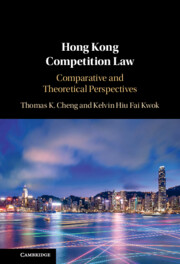Book contents
- Hong Kong Competition Law
- Hong Kong Competition Law
- Copyright page
- Contents
- Preface
- Acknowledgements
- Foreword
- Table of Cases
- Table of Legislation
- Table of Guidelines and Policy Documents
- Abbreviations
- 1 Introduction
- 2 First Conduct Rule
- 3 Second Conduct Rule
- 4 Exclusions and Exemptions
- 5 Enforcement and Procedure
- 6 Conclusion
- References
- Index
3 - Second Conduct Rule
Published online by Cambridge University Press: 13 October 2021
- Hong Kong Competition Law
- Hong Kong Competition Law
- Copyright page
- Contents
- Preface
- Acknowledgements
- Foreword
- Table of Cases
- Table of Legislation
- Table of Guidelines and Policy Documents
- Abbreviations
- 1 Introduction
- 2 First Conduct Rule
- 3 Second Conduct Rule
- 4 Exclusions and Exemptions
- 5 Enforcement and Procedure
- 6 Conclusion
- References
- Index
Summary
Regulation of unilateral conduct constitutes an abuse of dominance, or monopolisation, as it is known in the United States (the US), is an integral part of any competition law regime. Article 102 of the Treaty on the Functioning of the European Union (TFEU) prohibits abuse of dominance within the European Union (the EU). Section 2 of the Sherman Act in the US forbids monopolisation and attempt to monopolise. The Competition Ordinance1 (the Ordinance) is no exception. Section 21 of the Ordinance, which is termed the Second Conduct Rule (the SCR), is concerned with the abuse of market power. The market power necessary to trigger the corresponding provisions is called monopoly power under the Sherman Act and dominance under the TFEU. The SCR requires a substantial degree of market power. Given the legislative effort to model the Ordinance, in particular the key operative provisions, after EU law, the adoption of ‘a substantial degree of market power’ arguably represents a conscious decision to depart from the EU approach and warrants further exploration.
- Type
- Chapter
- Information
- Hong Kong Competition LawComparative and Theoretical Perspectives, pp. 115 - 189Publisher: Cambridge University PressPrint publication year: 2021

